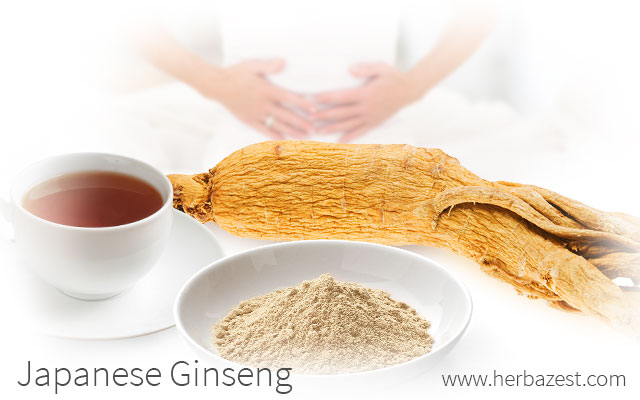Japanese ginseng, or Panax japonicus, is a Panax species cultivated in Japan since 1607. It grows in mountain forest areas and gets to be around 20 - 30 inches (50 - 80 cm) tall with four to seven leaflets, pale green flowers, and red fruits. Today, it is cultivated by Japanese rice farmers with an annual yield of 21,000 pounds (9,500 kg), the majority of which is exported to Hong Kong.
Traditional Uses of Japanese Ginseng
Japanese ginseng has been used in Traditional Chinese Medicine (TCM) as a substitute for Panax ginseng by minority ethnic groups in Japan, China, and other parts of Asia for hundreds of years. In Japan, dried rhizome extracts of P. japonicus have been used for gastroenteric disorders, as well as an antidiabetic, antiulcer, and expectorant supplement.
P. japonicus is believed to combine medicinal properties of P. ginseng and P. notoginseng by conserving vitality and replenishing blood. Both alleged benefits have earned Japanese ginseng a reputation as the king of herbs in TCM.
Benefits of Japanese Ginseng
Japanese ginseng has been trusted to treat a number of lifestyle-related diseases, such as arteriosclerosis, hyperlipidemia, hypertension, and non-insulin dependent diabetes. The extensive benefits of Japanese ginseng are credited to its high ginsenoside content, which is between two- to sevenfold higher than Panax ginseng.
Studies on Japanese Ginseng Benefits
A study published in the journal Asia-Pacific Traditional Medicine (2015) showed the hypolipidemic effect of Panax japonicus in mice. It concluded that the administrations of Japanese ginseng may help reducing the levels of total cholesterol, triglycerides, and low-density lipoprotein cholesterol (LDL-C).
A study published in BMC Complementary and Alternative Medicine (2005) suggests that Japanese ginseng may help prevent weight gain brought on by a high-fat diet, which is often a cause of lifestyle-related health issues, such as metabolic syndrome.
The Journal of Ethnopharmacology (2014) published a study that analyzed the effects of Japanese ginseng on blood cells. An accelerated recovery of white blood cells, red blood cells, and hemoglobin levels in mice was registered after the administration of Panax japonicus extract. These promising results suggest that Japanese ginseng may be useful in the treatment of anemia and other disorders related to the formation of blood cells.
Although additional studies suggest antiulcer and cardioprotective properties, Japanese ginseng still the least studied of the medicinal Panax species, and researchers acknowledge that further investigation is needed to understand the effects of its many active ingredients.
Japanese Ginseng Preparations
Although Japanese ginseng can be consumed in its raw form, ground into a powder, and used in meals, it has a bitterer taste than other ginseng species, which has prompted other methods of consumption that are quite popular. Japanese ginseng can be infused into a tea or energy drink, used as an extract, or taken in capsule or tablet form.
For home recipes, Japanese ginseng can be used the same way as other Panax species and in the same dosage.
Where to Buy Japanese Ginseng
Japanese ginseng is widely available at herbal and health stores, local pharmacies, and online retailers as a dried root, powder, tea, extract, or any hard form of supplement.
When buying Japanese ginseng, make sure to carefully read the labels of products, because many brands sell different types of ginseng in different concentrations, and it is easy to get confused.
Japanese ginseng has been used for hundreds of years to treat and prevent lifestyle-related diseases. Although many of its properties are yet to be discovered by science, a wide range of Japanese ginseng supplements are readily available, so you can start reaping all the benefits of this medicinal herb.
Sources
- Asia-Pacific Traditional Medicine, Hypolipidemic Action of Total Saponins of Panax Japonicus on Triton WR-1339 induced Hyperlipidemic Mice, 2015
- BMC Complementary and Alternative Medicine, Anti-obesity effects of chikusesusaponins isolated from Panax japonicus rhizomes, 2005
- Frontiers in Plant Science, RNA-seq Transcriptome Analysis of Panax japonicus, and Its Comparison with Other Panax Species to Identify Potential Genes Involved in the Saponins Biosynthesis, 2016
- Growing and Marketing Ginseng, Goldenseal and other Woodland Medicinals, p. 23
- Journal of Ethnopharmacology, Resource investigation of traditional medicinal plant Panax japonicus (T.Nees) C.A. Mey and its varieties in China, 2015 | The haematopoietic effect of Panax japonicus on blood deficiency model mice, 2014




